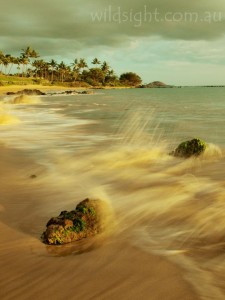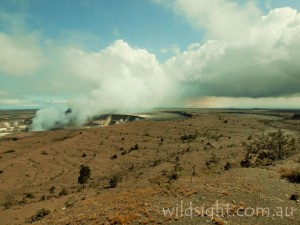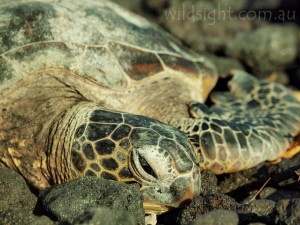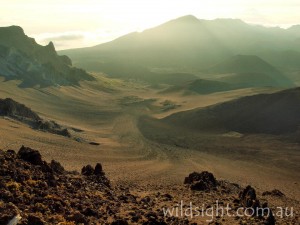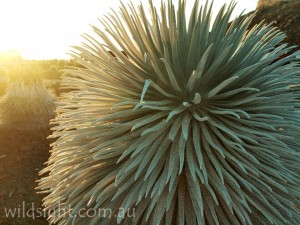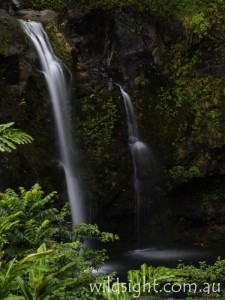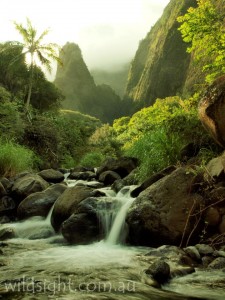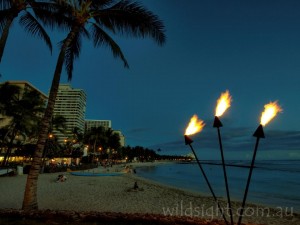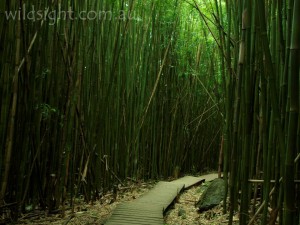Hawaii has all the elements of an incredible adventure destination: Earth (wild landscapes include rugged coastlines and the biggest mountains on earth), water (turquoise oceans, idyllic beaches and thundering waterfalls) and, at the heart of it all, fire, which has built the islands from the floor of the Pacific Ocean. Plus hula dancing.
The volcanic hot spot that features in all the tourist brochures and draws awe-struck visitors from around the world is responsible for the creation of 132 islands, reefs and shoals stretching more than 2400 kilometres from the Big Island of Hawai’i to Midway Island.
Hawaii’s volcanoes range from active to dormant and their fingerprints are everywhere, although some are more obvious than others. The result is an archipelago of stunning wild beauty with a surprising number and variety of excellent bushwalks.
If you’re into outdoor activities you’ll never get bored here, with other options including some of the world’s best snorkelling and SCUBA diving, mountain biking, kayaking, zip-lining through the jungle or the local favourite, stand-up paddleboarding (picture standing up on a boogie board with a kayak paddle). Throw in a stable warm year-round climate and the welcoming and relaxing ‘aloha’ spirit of the locals and it makes Hawaii the perfect winter getaway.
Most of Hawaii’s islands are uninhabited. Of the few that are, here are the highlights.
Hawai’i Island (aka the Big Island)
The Island of Hawaii is the youngest and the biggest in the chain – bigger than all the other major islands combined – and it’s still growing, thanks to the active volcanic cone at Pu’u O’o on the eastern slopes of the Kilauea volcano.
Kilauea has been erupting since 1983 with its lava flows adding 205 hectares to the island’s eastern shore (in the process also destroying 181 houses and a national park visitor centre). The volcano sits right on top of the fiery pit known as Halemaumau and is said to be home to Pele, the volcano goddess of ancient Hawaiian legends. It is also one of Hawaii’s main tourist drawcards.
Seeing the volcano in action is a day-today proposition; the lava flow stopped for almost a year before abruptly starting again in December 2012. But there is always something happening in Hawaii Volcanoes National Park.
A loop road circles the main Kilauea caldera, which spews volcanic gases and glows red at night; the Jaggar Museum offers the best view. To really experience this natural wonder leave the car behind and hit the park’s great network of walking tracks.
The Kilauea Iki Trail is a 6.4-kilometre trek across the frozen, but still steaming, floor of the Kilauea Iki Crater and through forests devastated by the crater’s spectacular 1959 eruption. You can extend the walk slightly by including a detour to Thurston Lava Tube to get a glimpse inside the volcano (take a torch). The four-kilometre Pu’u Huluhulu track crosses massive lava fields while the 1.6-kilometre Devastation Trail is another option with great views. To see molten lava, you’ll need to drive to the end of Chain of Craters Road and walk across the recently solidified flows. Wear sturdy shoes, take a torch and consult rangers before heading out.
There is a lot more to the Big Island than Kilauea. It’s arguably not even the island’s most impressive volcano. That honour could go to Mauna Loa – which has erupted three times in the past century – or the massive Mauna Kea, the tallest mountain on Earth when measured from the base. The extinct volcano rises 9750 metres from the ocean floor and although most of that is underwater, what we see above sea level – all 4205 metres of it – is still mighty impressive. The summit is one of the world’s great sunset viewing spots and the altitude, pure air and the remoteness of the peak make it a Mecca for stargazers – there are 13 working telescopes at the summit. The public road stops at the Onizuka Center for International Astronomy at 2750 metres. To get higher you’ll need a four-wheel drive or join a guided tour, or take the 9.7-kilometre walking track – the track is extremely strenuous, so start early.
Mauna Loa, which rises majestically to the south of Mauna Kea, is slightly lower at 4169 metres, but it is less crowded and you can walk all the way to the top from the base. The walk isn’t technically difficult but the altitude and local conditions (official guides warn ‘volcanic eruptions can happen at any time’) make this a trek only for experienced walkers prepared to spend three or four days on the trail, staying at one of two hikers’ cabins close to the summit. If you don’t have that long you can reach the peak in a day on the Mauna Loa Observatory Trail (21.2-kilometre round trip).
Walking the dry lunar landscapes of Mauna Loa and Mauna Kea, it’s hard to imagine the eastern side of the island is a lush tropical paradise; in fact, the rain shadow created by the mass of Mauna Kea is the most severe in the world. Two walks to add to your must-do list are the Muliwai Trail into the stunning Waimanu Valley (14 kilometres each way, camp overnight in the valley), and the ‘Akaka Falls Loop, an easy 30-minute stroll that winds through rainforest to a jaw-dropping 135-metre waterfall. If you need time to relax after all the exertion, there are beautiful beaches on the western coast – lined with palm trees, they appear as tropical oases after kilometres of desolate lava flows. Anaeho’omalu Bay near Waikoloa is a great spot to see an endangered green sea turtle.
Maui
The second youngest of the Hawaiian islands manages to contain a sample of essentially every landscape the state has to offer, including lush rainforests, sweeping beaches backed by palm trees and rocky coves and waterfalls, all centred around rugged mountain peaks. About the only thing it’s missing is active lava flows, although even that’s not a given; the island’s volcanoes are technically listed as ‘dormant’ and geologists expect that they will erupt again sometime in the next few hundred years.
The scenic highlight of Maui – if not the entire island chain – is sunrise from the summit of Haleakala, the island’s central peak, where on a clear day you can clearly see the even higher peaks of Mauna Kea and Mauna Loa on the neighbouring Big Island, while below the 760-metre deep summit crater (formed by erosion, not a volcanic eruption) stretches across the roof of Maui.
The whole scene has an other-worldly quality to it, with small volcanic cones scattered through the crater and only a few hardy grasses and the endemic (and alienlooking) Haleakala silver sword occasionally poking their way through the scoria to show that life can exist in this harsh environment. The national parks service has constructed an excellent network of tracks that thread their way through the crater, as well as three huts which come complete with woodburning stoves, gas cookers, cooking utensils, padded bunks, pit toilets and a nearby water supply. The best route involves descending from the summit and crossing the crater floor for 14.3 kilometres to Palik cabin, then on the second day taking a more northerly track to exit via the Halemau’u Trailhead, a distance of 16.1 kilometres.
Either way you will probably find yourself diverting for some distance on some of the many side tracks to take a closer look at cinder cones, cliffs, lava flows and other landmarks. Shorter and longer options are available too – the shortest route between the summit and Halemau’u is a six-hour walk and the Pu‘u o Pele cinder cone is a 10-kilometre return trek on the Sliding Sands Trail, while for those who wish to explore for several days Holua and Kapalaoa cabins can be linked by cross-tracks to form a variety of interesting walks.
The Hana Highway could not be a greater contrast to the arid uplands of Haleakala. The road, which winds for 84 kilometres along Maui’s wild northeast coastline from Pa’ia to the tiny hamlet of Hana, passes rainforest, remote beaches, waterfalls and the occasional terrified visitor attempting to negotiate the 617 bends and 56 one-lane bridges that make this one of the more hair-raising tourist drives in the world. The best is still to come, however, as an hour past Hana the road arrives at the Pipiwai Trail, which at 6.5 kilometres and two hours return is probably the best day walk in Hawaii. Starting at the ‘Ohe’o Gulch visitor centre, the track winds through lush forest, passing several waterfalls and then entering a dense bamboo forest. Bamboo is not native to Hawaii but it has made itself at home here, growing more than 10 metres high, and the atmosphere at ground level when the wind whistles through the canopy and the hollow stems grind against each other is quite spooky. Past the bamboo lies more rainforest and the destination of the walk, the massive 120-metre Waimoku Falls which plunge over mossy cliffs into a tiny plunge pool. On the return trip down the Hana Highway remember to stop and pick up some fresh tropical fruit at one of the many stalls beside the road.
Beyond Hana and Haleakala the more settled landscapes of southern and western Maui are also well worth a visit. Located just outside the urban centre of Wailuku, the one-kilometre Iao Needle lookout walk includes lush rainforest and spectacular views of the needle, a 400-metre spire of volcanic rock used as a lookout during a key battle fought by King Kamehameha I in 1790 during his unification of the islands.
O’ahu
You can’t avoid O’ahu, if for no other reason that’s the destination for all Australian flights into Hawaii. It’s also the most tourist-friendly island and nowhere is more geared to tourists than Waikiki, the Las Vegas of the Pacific (minus the gambling). To balance the bright lights, O’ahu also has some some excellent walking tracks and they are all within easy reach.
The nearest, and most popular, leads to the top of Diamond Head, the rugged mountain in the background on all those Waikiki postcards. The peak can be reached on a steep 1.3-kilometre track (allow an hour for the return trip) via several tunnels and staircases and offers fantastic 360-degree views.
On the northeast side of the island, a more dramatic climb leads to three rugged peaks in the mountains that rise above Kailua. The Olomana Trail is a 4-kilometre (3-hour) day hike with an elevation gain of more than 300 metres – ropes assist in the trickiest sections – through landscapes that make you feel like an extra in Jurassic Park or Lost. That’s not surprising since both productions were filmed in this area – you can walk right through filming locations on the 1.4-kilometre track to Manoa Falls in Honolulu Watershed Forest Reserve. If it’s beaches you’re after, head to the north shore, home to the world’s top surfing events. The truly monster waves roll in from November-February.
Moloka’i
This small and sparsely populated island between O’ahu and Maui is the opposite of Waikiki – remote and undeveloped, and the locals take pride in keeping it that way. And there is probably no further from the beaten track than a visit to a historic leper colony. A spectacular walking track leads into the depths of the Kalaupapa National Historic Park on the north coast. It’s only 4.7 kilometres from the trackhead to the valley floor but that includes 26 switchbacks descending the world’s highest sea cliffs. At the bottom is a community founded by Belgian missionary St Damien; official exile for disease victims ended in 1969 but the colony still treats patients who chose not to leave. Respect their privacy and obtain a permit. Start early to make a day trip or join a tour and stay overnight in the valley, which is also home to a beautiful deserted beach.
The other reason to visit Moloka’i is the Pepeopae Trail, an easy 4.5-kilometre stroll on a narrow boardwalk through a miniature primeval forest en route to an ocean lookout – although the view is often obscured by fog. You’ll need a four-wheel drive to reach the trackhead.
Kaua’i
Kaua’i is the oldest of the main Hawaiian islands, and it shows; the forces of erosion have worn away at the extinct volcanoes until only their jagged skeletons remain. The most famous landscape on the island is the NaPali coast, a rugged 26-kilometre section of coastline where isolated coves and beaches are interspersed with massive pali (cliffs) soaring as much as 1200 metres above the waves. If you have time and a head for heights you can undertake the 35-kilometre return walk on the Kalalau Trail, which traverses some of the most rugged parts of the coast and has the added attraction of side trips to Hanakapi’ai and Hanakoa Falls and the Kalalau Valley. The full trek takes 2-3 days, with overnight camping at Hanakoa Valley and at the end of the track at Kalalau Beach.
The 6.4-kilometre return walk to Hanakapi’ai Beach and 12.8-kilometre trek to Hanakoa provide shorter options for visitors interested in day hiking. Be aware that tracks in this area are rough and traverse steep climbs and descents above often-precipitous drops, and swimming conditions at the ocean beaches are often dangerous.
Only a few kilometres away as the crow flies, but accessed from the south coast of the island, is Kaua’i’s other natural wonder. Nicknamed the Grand Canyon of the Pacific, Waimea Canyon is a massive gouge 16 kilometres long and more than 700 metres deep carved by the Waimea River through lava flows from the island’s volcanoes. The lookouts on Waimea Canyon Drive provide fantastic views, while the 8-kilometre Kukui and 9.6-kilometre Koai’e tracks allow hikers to descend into the depths of the canyon – stop 1.5 kilometres down the Kukui Trail to drink in one of the world’s most remarkable landscapes.
HAWAII’S BEST WALKS
Pipiwai Trail (Maui)
6.5km, 2 hours
A gentle climb through lush rainforest and an eerie bamboo forest to reach the awesome 120-metre Waimoku Falls.
Diamond Head (O’ahu)
2.6km, 1 hour
A historic track climbs via tunnels and stairways to 360-degree views high above the iconic Waikiki Beach.
Kalalau Trail (Kaua’i)
35km, 3 days
Traverse some of the world’s most spectacular coastal scenery, Kaua’i’s NaPali coast, with side tracks to steep valleys and waterfalls.
Kalaupapa Trail (Moloka’i)
9.4km, 4 hours
Descend the world’s highest sea cliffs via endless switchbacks to a deserted beach and historic leper colony.
Pepeopae Trail (Moloka’i)
4.5km, 1.5 hours
A walk back in time to see an ecosystem that hasn’t changed in millions of years.
Mauna Loa summit (Big Island)
41km, 3-4 days
Widely considered the hardest hike in Hawaii, climbing the awe-inspiring 4169-metre volcano. Conditions vary from tropical at sea level to sub-arctic at the summit. Hypothermia and altitude sickness are real dangers – walk slowly and don’t take risks. Stay overnight at the Pu’u ‘Ula’ula Rest House or Mauna Loa Cabin – beds are available on a firstcome, first-serve basis. Walkers must register at the Kilauea Visitor Centre.
Kilauea Iki Trail (Big Island)
6.4km, 2-3 hours
Follow the southern rim of Kilauea Iki Crater through forest destroyed by volcanic eruptions, then drop on switchbacks and cross the barren crater floor before returning to the trackhead.
OTHER HAWAIIAN ADVENTURES
Walking isn’t the only way to experience Hawaii’s amazing landscapes. Here’s a sample of some of the other great outdoor experiences on the islands.
Swim with manta rays on the Big Island
Garden Eel Cove near Kona is world famous for close encounters with the ocean’s gentle giants.
Kayak the NaPali Coast
A different way to see the incredible coastal scenery on Kaua’i. For experienced kayakers only.
Dive or snorkel at Molokini Crater
Hawaii is famous for snorkelling, and this spot is famous even within Hawaii. Themostly submerged volcanic crater five kilometres off the coast of Maui is teeming with tropical fish, turtles and white-tipped reef sharks.
Surf O’ahu’s North Shore
The waves at Ehukai Beach Park are renowned for their perfect shape and their size – they average three metres but can get much bigger. Not for novices.
Hawaii Ironman
The annual 3.8-kilometre swim, 180-kilometre cycle and 42-kilometre run on the baking lava fields of the Big Island is the world’s most brutal triathlon. Aussies have won the past six events.
This article appeared in the March-April 2013 edition of Wild magazine
